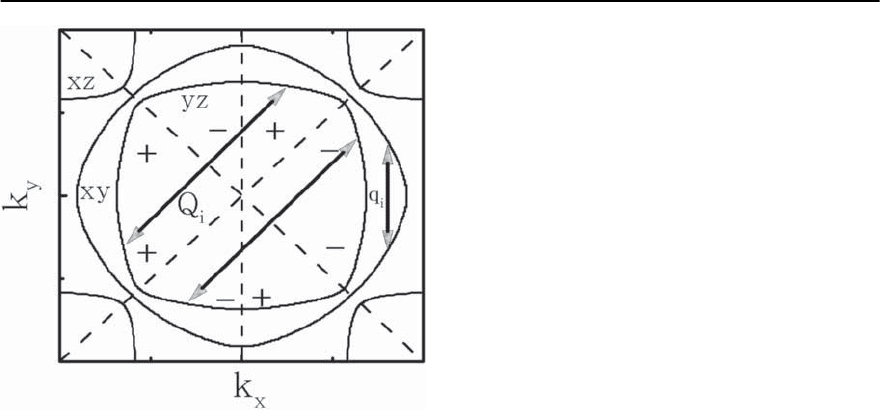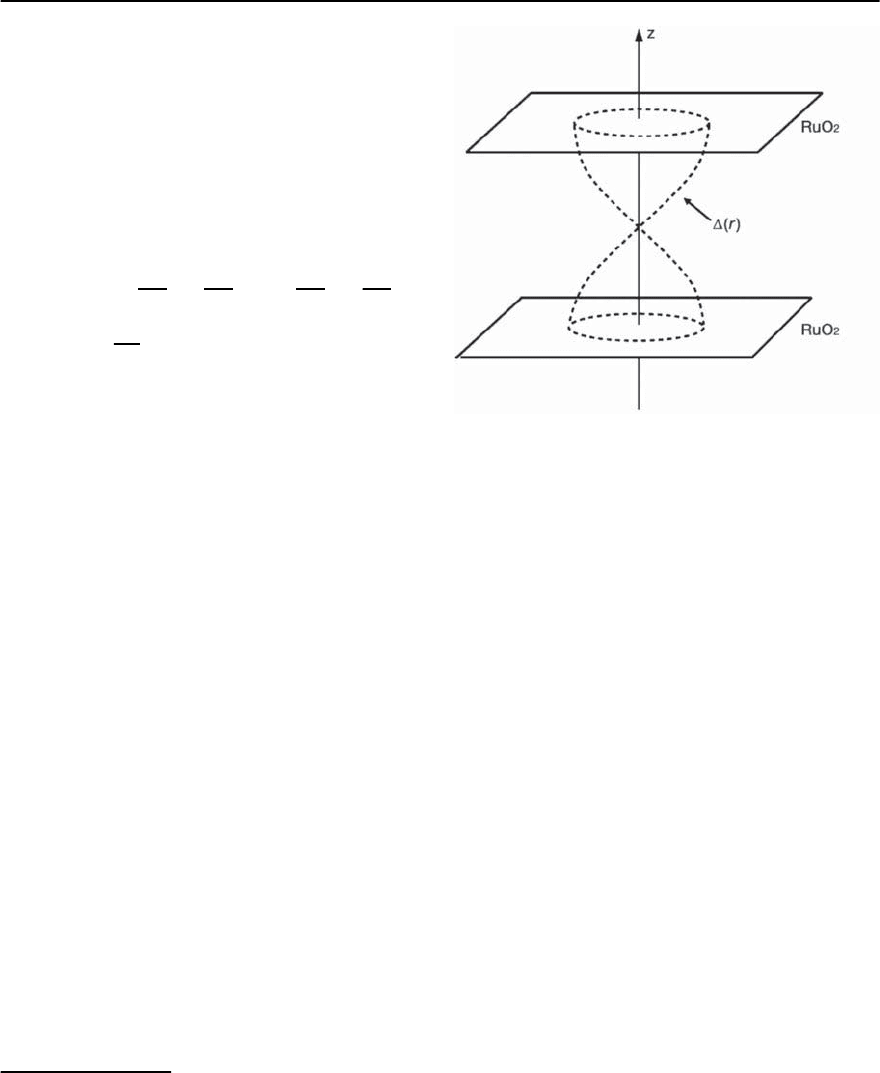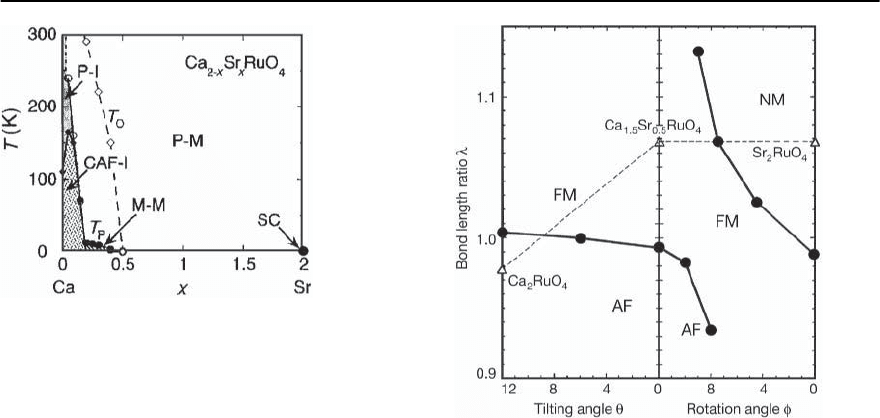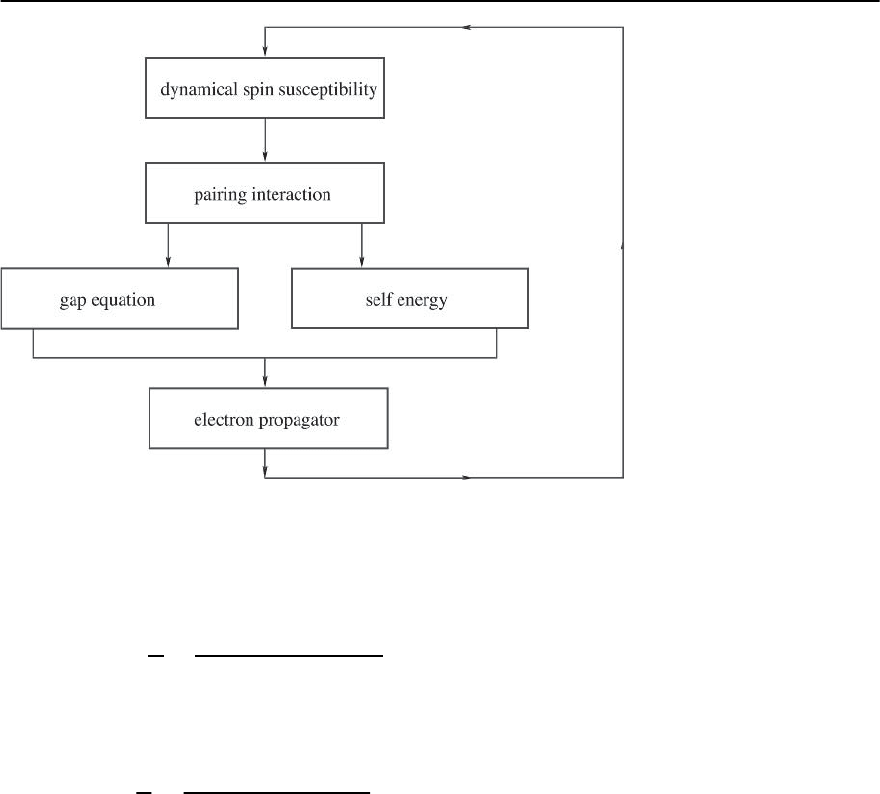Bennemann K.H., Ketterson J.B. Superconductivity: Volume 1: Conventional and Unconventional Superconductors; Volume 2: Novel Superconductors
Подождите немного. Документ загружается.


1492 D. Manske,I. Eremin, and K.H.Bennemann
Fig. 23.71. Symmetry analysis of the order parameter for
triplet pairing with | m |= 1 in the first BZ for k
z
=0.The
wave vectors Q
i
and q
i
arethepronouncedwavevectors
resulting from the susceptibility (without spin–orbit cou-
pling). For f
x
2
−y
2 -wave symmetry the nodes of the real part
of the order parameter are shown (dashed lines)andthe
regions +(–) where the f
x
2
−y
2 -wave superconducting gap is
positive (negative). Note that for the real part of a p-wave
order parameter the node would occur only along k
x
=0
opposite and equal sign. Therefore, for the xy-band
we get no solution with f
x
2
−y
2
-wave symmetry. On
the other hand, for the xz and yz-bands the wave
vector Q
i
bridges portions of the FS with equal signs
of the f
x
2
−y
2
-superconducting order parameter. The
eigenvalue of this order parameter is also enhanced
due the interband nesting for xz and yz-bands. Thus,
superconductivity in the xz and yz-bands in the
RuO
2
plane would be possible with the f
x
2
−y
2
-wave
order parameter. Therefore, solving (23.144) for the
three-band picture we found a competition between
triplet p-wave and f
x
2
−y
2
-wave superconductivity in
the RuO
2
-plane.
Also using (23.147) we can rule outsinglet pairing.
In particular,assuming d
x
2
−y
2
-symmetry for Sr
2
RuO
4
(23.144)yields an eigenvalue that is lower than in the
case of triplet pairing.As can be seen using Fig.23.71
this is plausible. Note that for d
x
2
−y
2
-wave symme-
try we get a change of sign of the order parameter
upon crossing the diagonals of the BZ. According to
(23.144)wavevectorsaroundQ
i
connecting areas(+)
and(–) contribute constructivelyto thepairing.Con-
tributions due to q
i
and the background connecting
areas with the same sign would subtract from the
pairing (see Fig. 23.71 with nodes at the diagonals).
Therefore, we get that the four contributions due to
q
i
in the xy-band do not allow to have d
x
2
−y
2
-wave
symmetry in the xy-band. Despite the pair-building
contributiondue to Q
i
one gets that the eigenvalue of
the d
x
2
−y
2
-wave symmetry in the xy-band is smaller
than for the f
x
2
−y
2
-wave symmetry. This is due to the
large contributionfrom Q
i
to the cross-terms for the
triplet pairing,which are absent for the singlet pair-
ing.For d
xy
-symmetrywherethenodesarealongthe
(,0) and (0,)-directions we argue similarly. Thus,
we may exclude this symmetry. We safely conclude
that as a result of the topology of the FS and the spin
susceptibilityfor p and f -wave symmetry we seem to
get the strongest pairing. We can definitely exclude
d-wave pairing in the RuO
2
-plane.
Since we have found a strong competition be-
tween p-wave and f
x
2
−y
2
-wave superconductivity in
the RuO
2
-plane the question arises as to what is the
role of the c-axis in determining the superconduct-
ingproperties in Sr
2
RuO
4
.Doesthisquestionrequire
an understanding of the role of spin–orbit coupling
for the determining the symmetry of the supercon-
ducting order parameter?
First, the spin–orbit coupling affects the spin
dynamics and as we have shown induces the
anisotropy in the spin subspace. In particular, the
two-dimensional IAF at Q
i
=(2/3, 2/3) align
along the c-direction.Thissimply means that the an-
tiferromagnetic moments associated with these fluc-
tuations align along the z-direction.At the same time
the ferromagnetic fluctuations are in the ab-plane.
Since the interaction in the RuO
2
-plane (k
z
=0) is
mainly ferromagnetic nodeless p-wave pairing is in-
deedpossible and the superconducting order param-
eter in all three bands will not have nodes and not
only forxy -band as before. Notealso that the -band
reveals a high density of states. Therefore, the triplet
p-wave pairing without line-nodes will be realized in
the RuO
2
-plane.
On the other hand, the state between the RuO
2
-
plane will be determined mainly by the IAF that

23 Electronic Theory for Superconductivity 1493
are polarized along the c-direction. This implies that
the magnetic interaction between the planes has
to be rather antiferromagnetic than ferromagnetic.
This antiferromagnetic interaction suggests a line
of nodes for (k) between the neighboring RuO
2
-
planes. In a phenomenological approach this was
shown by two groups [169–171]. For example, it was
proposed that the symmetry of the superconducting
order parameter in Sr
2
RuO
4
will have the form
k
=
0
˜z
sin
k
x
a
2
cos
k
y
a
2
+ i sin
k
y
a
2
cos
k
x
a
2
×cos
k
z
c
2
. (23.150)
Then, due to the magnetic anisotropy induced by
spin–orbit coupling a nodeless p-wave pairing is
possible in the RuO
2
-plane, as observed experimen-
tally [168]. Thus, a node would lie between the
RuO
2
-planes. This is illustrated in Fig. 23.72. Indeed
as observed by thermal conductivity measurements
[168,169], the nodes in the superconducting order
parameter are between the RuO
2
-planes.
Note that the spin–orbit coupling also determines
the orientation of the orbital moment of the Cooper-
pair. In particular, it is convenient to combine the
threespin component into a vector d(k)inspinspace.
As mentioned earlier this is achieved by the expand-
ing
k
in the three symmetric 2 × 2matricesi
2
,
=1, 2, 3, where
are the Pauli matrices as
k
=
d
(k)(
i
2
)=
−d
x
+ id
y
d
z
d
z
d
x
+ id
y
.
(23.151)
Then, in a triplet superconductor, the pairing state
can be represented by the three-dimensional vec-
tor d(k), whose magnitude and direction may vary
over the Fermi surface in k-space. Like in
3
He several
pairing states related to the different orientation of
the total spin moment of the Cooper-pair d
z
, d
y
, d
z
mayhavethesamecondensationenergyunderweak-
coupling conditions.This degeneracy is related to the
spin rotation symmetry being present in
3
He (which
Fig. 23.72. Schematic representation of the possible node
formation in the order parameter between the RuO
2
-
planes (in real coordinate representation) as resulting from
the magnetic anisotropy. Here, the amplitude of the or-
der parameter along the z-direction has been drawn in
cylindrical coordinates between RuO
2
-planes. This seems
in agreement with thermal conductivity measurements be-
low T
c
[168,169]
leads to the presence of a so-called B-phase), but this
is lifted by the spin–orbit coupling in Sr
2
RuO
4
[108].
Thus, the analogy of the A-phase in
3
He occurs in
Sr
2
RuO
4
(d(k)
A
= (0,0,d
z
(k
x
± ik
y
))), while the B-
phase might be suppressed (d(k)
B
=(d
x
k
x
, d
y
k
y
, 0)).
This B-phase corresponds to S
z
=0.Asonecansee
from (23.106), we get that the transverse susceptibil-
ity and thus V
+−
sp
is larger than V
zz
sp
for q 0(see
Fig. 23.67).
14
ThistendstosuppresstheB-phase.
The different orientation of the spin and orbital
angular momenta of the Cooper-pair is illustrated
in Fig. 23.73. The important consequence of this or-
der parameter is the uncompensated orbital angular
momentum of the Cooper-pair (the so-called “chi-
ral” state). Why is the chiral state (k)=d
z
(sin k
x
±
i sin k
y
) realized? To understand this, one has to con-
sider the additional contribution of the spin–orbit
coupling (l
CP
·s) to the free energy in the supercon-
14
We note that for the sake of simplicity the momentum dependence of the gap function was illustrated in the previous
sections by the use of (23.104),which correspondsto | m |= 1 rather than (23.106),which requires a more sophisticated
analysis.

1494 D. Manske,I. Eremin, and K.H.Bennemann
Fig. 23.73. Illustration of the possiblesuperconducting states in Sr
2
RuO
4
taken from [172].Spin and total angular momen-
tum for (a) (k)=d
z
(sin k
x
+i sin k
y
)and(b) (k)=d
x
sin k
x
+d
y
sink
y
.The(k)=d
z
(sin k
x
+i sink
y
) superconducting
state has an angular momentum along the c-axis (thick arrow) and the spin lying in the RuO
2
-plane. Note that the chiral
state displayed in (a) is obtained from our eigenvalue analysis
ducting state. Here, l
CP
refers to the orbital moment
of a Cooper-pair and s denotes the electron spin.
In a simple mean-field analysis the components of
s are replaced by s
i
∼
ij
· H
j
where
ij
refers to
the transversal (
+−
) and longitudinal (
zz
)compo-
nent of the magnetic susceptibility.Obviously,dueto
zz
>
+−
(see Figs. 23.67 and 23.68) the degener-
acy of the states (k) is lifted, since one gains more
energy if the orbital moment of a Cooper-pairs is
aligned along the z-direction. Thus, the chiral state
has the lowest energy [108,171].
In analogy to
3
He, interesting effects can be ob-
served by applying an external magnetic field or ex-
ternal pressure along ab-plane to Sr
2
RuO
4
.Forex-
ample, in
3
He under pressure the transition from B
to A phase has been observed. In Sr
2
RuO
4
the situ-
ation is the opposite. Superconductivity in Sr
2
RuO
4
is already in the A-like phase and therefore, by ap-
plying pressure or magnetic field one could cause
the transition into B-like phase. However, if the -
band becomes more nested due to external pressure,
an f -wave order parameter is possible. Another in-
teresting effect concerns the possible change of the
orientation of the unit vector d
z
= ˆz of the super-
conducting order parameter induced by the external
magnetic field discussed in Sect. 23.3.5. This means
that for a relatively large magnetic field applied along
the c-directionthe significant d
x
and d
y
components
in the superconducting order parameter in Sr
2
RuO
4
can be induced. Of course, this effect is relatively
small (as also in
3
He)butcanbeobserved.
In summary,Sr
2
RuO
4
is a remarkable exampleof a
system where the interplay of ferromagnetic and in-
commensurate antiferromagnetic fluctuations may
result in a non-trivial symmetry of the supercon-
ducting order parameter. Note that the nesting of ˛
and ˇ-bands may, as we have shown, lead to a node
formation in the superconducting gap. Although its
existence has not yet been definitely concluded ex-
perimentally it can be verified by applying a mag-
netic field or pressure. Since the antiferromagnetic
fluctuations are not helpful for the triplet pairing,
one may expect an enhancement of the supercon-
ducting transition temperature and the nodeless su-
perconducting gap if the nesting is suppressed. In-
terestingly, this phenomenon was proposed to be
responsible for the occurrence of superconductivity
in the ferromagnetic phase [173] of unconventional
superconductors like ZrZn
2
and UGe
2
. In particu-
lar, we have shown that spin–orbit coupling plays
an essential role in stabilization of the A-like phase
in Sr
2
RuO
4
and might be responsible for the pos-
sible node formation between neighboring RuO
2
-
planes.
23.5.5 Doping Dependence of Ruthenates
Comparing ruthenates and cuprates one can clearly
see that their behavior differs drastically in the nor-
mal state. The ruthenates are good Fermi-liquid
systems despite of the presence of IAF at Q
i
=
(2/3, 2/3). On the other hand, cuprates can be
characterized as systems that may behave mainly
non-Fermi-liquid-like. The most remarkable is the
doping concentration dependence of the cuprates
properties. The electronic correlations are more im-
portant in cuprates. The on-site Coulomb repulsion
U (which can be roughly estimated as e
2
/r where r
refers to the radius of the corresponding electronic
shell) is much larger than the bandwidth. In the

23 Electronic Theory for Superconductivity 1495
Fig. 23.74. Phase diagram of Ca
2−x
Sr
x
RuO
4
.P refers to para-
magnetic,CAFto cantedantiferromagnetic,M to magnetic,
SC to the superconducting phase,–M to the metallic phase,
and –I to the insulating phase
ruthenates that are 4d-electron systems the effect of
correlations is weaker than in cuprates and U is of
order of the electronic bandwidth,W. Therefore,one
concludes that in ruthenates we are in the interme-
diate correlation regime. As a result, in the ruthen-
ates the correlations are not strong enough to violate
Fermi-liquid theory.Nevertheless,correlations in the
ruthenates also occur.Thisis obviousfrom Fig.23.74.
In Fig. 23.74 we show results for the magnetic
phase diagram obtained experimentally by Nakat-
suji and Maeno [174] for Ca
2−x
Sr
x
RuO
4
. Despite the
fact that introducing Ca does not change the valence
in the system the magnetic phase diagram changes
completely. First, superconductivity disappears and
systems remain paramagnetic metals up to x =0.5.
Then, the system becomes a ferromagnetic metal.
Most remarkably, upon further doping an insulating
antiferromagnetic transition occurs.
Note that introducing a Ca instead of an Sr ion al-
lows to have structural distortion of the pure tetrag-
onal crystal lattice of Sr
2
RuO
4
due to the smaller ra-
dius of the Ca ionic sphere. This was discussed by
Fang and Terakura [175] by means of LDA calcu-
lations. Their main results are shown in Fig. 23.75.
First, between 0 < x < 0.5theRuO
6
octahedra gets
rotated around the c-axis. This basically changes the
hopping term of the xy-band and most importantly
brings the van Hove singularity closer to the Fermi
level enhancing the ferromagnetic fluctuations and
leading to a ferromagnetic state at x =0.5. Further
Fig. 23.75. The calculated magnetic phase diagram of
Sr
2
RuO
4
including structural distortions,taken from [175].
The solid lines are calculated phase boundaries, while the
triangles linked by dashed lines correspond to the experi-
mental data
doping with Ca allows one to have not only the rota-
tion of the RuO
6
octahedra, but also its tilting. Thus,
hopping in the xz and yz-bands reduces. As a con-
sequence, the Coulomb repulsion U will be larger
than the bandwidth of the conduction bands.The re-
sulting increase of correlations cause a Mott insula-
tor transition driven by the IAF fluctuations. Further
studies of the resistivity in Ca doped samples will
justify the proposed scenario.
Summary
To summarize in this section we have studied triplet
superconductivity. Sr
2
RuO
4
is a solid state system
for which unconventional triplet superconductiv-
ity may occur. We have shown that spin fluctua-
tions may explain qualitatively the occurrence of p-
wave superconductivity with line nodes between the
RuO
2
-planes. Furthermore, due to the presence of
ferromagnetic and incommensurate antiferromag-
netic fluctuations Sr
2
RuO
4
seems to be an ideal sys-
tem where the role and competitions of various spin
fluctuations for the formation of superconductivity
can be studied in detail. In particular, we have seen

1496 D. Manske,I. Eremin, and K.H.Bennemann
that incommensurate antiferromagnetic spin fluctu-
ations are not helpful for triplet pairing and may re-
sultin theformation of line nodesbetween neighbor-
ing RuO
2
-planes. The relative simplicity of this com-
pound in comparison to heavy-fermion supercon-
ductors could make Sr
2
RuO
4
the model system where
further interesting and exciting physics (in partic-
ular regarding thermodynamical properties, effects
due to magnetic and non-magnetic impurities, etc.)
will be discovered.
23.6 Summary and Outlook
In this review we present a microscopic theory us-
ing a model Hamiltonian for the interactionbetween
quasiparticles and spin fluctuations. This is applied
to the layered cuprates and Sr
2
RuO
4
.Forsimplic-
ity we assume that the electronic dynamics is es-
sentially controlled by the CuO
2
and RuO
2
-planes,
respectively.
For the description of singlet superconductivity in
the cuprates we employ a one-band model Hamilto-
nian.The interaction between the carriers (quasipar-
ticles) is described by an effective Coulomb coupling
U and the itinerancy of the carriers by a hopping in-
tegral t.In the case of hole doping the states of the ef-
fective band are mainly the hybridized p-states origi-
nating from the O-atoms.The spin fluctuations arise
from the magnetic activity of the Cu-spins and the
induced spin polarization of the p-states. In the case
of electron doping the effective one-band Hamilto-
nian describes the hybridized d-states of the UHB
and U is an effective coupling between the electrons
in these states. The spin fluctuations result from the
Cu-spins. Upon doping the Cu-spins are quenched
and the spin polarization of the band is reduced. We
assume itinerant magnetism for the carriers in the
UHB.
Using this model we have found that the phase di-
agram, the symmetry of the superconducting order
parameter, and the behavior of the elementary and
spin excitations in hole-doped and electron-doped
cuprates can be largely understood.We have found a
particularly interesting behavior forthe underdoped
cuprates. (Note, however, that for smaller doping our
theory needs to be extended.) Due to strong scatter-
ing of quasiparticles by antiferromagnetic spin fluc-
tuations a “weak” pseudogap appears at the Fermi
level in the density of states. It increases with de-
creasing doping concentration. The spectral density
has different weightsfor holesand electrons.Cooper-
pair phase fluctuations in underdoped cuprates are
enhanced by the reduced dimensionality and also
since phase-incoherent Cooper-pairs do not over-
lap well, resulting in a small n
s
. These fluctuations
of phase-incoherent Cooper-pairs destroy the long-
range superconducting order and the Meissner ef-
fect. In conventional bulk superconductors this is
not relevant, since the large superfluid density leads
to a typical energy scale of phase fluctuations much
larger than the superconducting energy gap that
governs the thermal breaking of Cooper-pairs. Thus,
in conventional superconductors the superconduct-
ingtransitionisduetothe destructionof the Cooper-
pairs and T
c
is proportional to
0
.Wehavefound
T
c
∝ n
s
in underdoped hole-doped cuprates indicat-
ing that the phase fluctuations drive the transition.
The Cooper-pairs only break up at a crossover tem-
perature around T
∗
c
, T
∗
c
> T
c
. T
∗
c
is approximately
givenbythe transitiontemperature onewouldobtain
without phase fluctuations. Between T
c
and T
∗
c
local
Cooper-pairs without long-range phase coherence
may be present. Therefore, we conclude that we may
have a qualitative understanding of the phase dia-
gram in the cuprates. Furthermore,the important el-
ementary excitations and their interdependence with
spin excitations (resonance peak) can be well under-
stood within our theory. Our results also shed light
on the asymmetry of hole-doped and electron-doped
cuprates.
For describing triplet Cooper-pairing in Sr
2
RuO
4
we also employ a Hubbard Hamiltonian. In order to
derive an electronic theory we take the electronic
band structure of Sr
2
RuO
4
into account. Magnetic
activity arises from the itinerant electrons in the
Ru d-orbitals. Due to spin–orbit coupling a strong
magnetic anisotropy occurs (
+−
<
zz
)inthenor-
mal state. This mainly results from different values
of the g-factor for the transverse and longitudinal
components of the spin susceptibility (i.e. the ma-
trix elements differ) and from a change of the bare
energy dispersion of the d-electrons. Obviously,this

23 Electronic Theory for Superconductivity 1497
and the presence of incommensurate antiferromag-
netic and ferromagnetic fluctuations have conse-
quences for the symmetry of thesuperconducting or-
der parameter. In particular, using spin-fluctuation-
induced Cooper-pairing one can understand how p-
wave Cooper-pairing with line nodesbetween neigh-
boringRuO
2
-planes may occur.
Despite the relative success of the Eliashberg-like
treatment of superconductivityvia spin fluctuations
exchange in cuprates and ruthenates there remain
critical questions. In particular, in the theory of
cuprates it is necessary to clarify the role ofthe vertex
corrections and to which extent an effective second-
order perturbation theory canbe applied.It might be
useful to take the original Hamiltonian referring to
Cu-spins and polarized p-states at oxygen sites and
derive the magnetic activity (spin-susceptibility,sta-
bility of local Cu-spins,etc.) and the itinerancy of the
carriers. Also canonical transformation theory and
slave-boson type theory should be used as alternative
treatments. In the underdoped cuprates the origin
of the pseudogap and the coexistence of short-range
weak antiferromagnetismand superconductivity has
to be understood. Also the symmetry of the super-
conducting order parameter in overdoped electron-
doped cuprates must be clarified. In the ruthenates
the thermodynamical properties remain to be stud-
ied in detail. It is of interest to apply our theory also
to superconductivity in heavy-fermion systems ex-
hibiting spin fluctuations as well.
Appendix A:
Derivation of the Generalized Eliashberg
Equations for the Interaction of Quasiparticles
and Spin Fluctuations
Here, we present the derivation of the generalized
Eliashberg equations for the interaction of quasi-
particles and spin fluctuations in a detailed form,
however, without discussing the relevancy of the ap-
proximations we used. This is discussed in the main
text [176–179].
We start with Green’s function for itinerant elec-
trons (holes). Using the Nambu notation for the su-
perconducting state [69], the one-particle Green’s
function is a 2 ×2-matrix
ˆ
G(k, i!
n
)=
ˇ
0
d e
i!
n
ˆ
G(k, ) , (23.152)
where
ˆ
G(k, )=−T
k
()
†
k
(0),
k
()=
c
k↑
()
c
†
−k↓
()
. (23.153)
We employ the Heisenberg picture:
c
k
() ≡ e
H
c
k
e
−H
, (23.154)
and
¯c
k
() ≡ e
H
c
†
k
e
−H
, (23.155)
where corresponds to an imaginary time. Thus,
we define the matrix elements of the one-particle
Green’s functions as
G
˛ˇ
(k, )=−T
c
k˛
()c
†
kˇ
,
¯
G
˛ˇ
(k, )=−T
¯c
−k˛
()c
−kˇ
,
F
˛ˇ
(k, )=−T
c
k˛
()c
−kˇ
,
¯
F
˛ˇ
(k, )=−T
¯c
−k˛
()c
†
kˇ
. (23.156)
In order to obtain the renormalized single-particle
Green’s function we solve the Dyson equation
ˆ
G
−1
=
ˆ
G
−1
0
−
ˆ
£ . (23.157)
This relates the matrix representing the bare propa-
gator
ˆ
G
0
and its renormalization due to the sum of
all irreducible self-energy diagrams
ˆ
£ to the dressed
propagator
ˆ
G. The Dyson equation reads in Nambu
space
ˆ
G
−1
=
G
−1
0
− £
G
−£
F
−
¯
£
F
¯
G
−1
0
−
¯
£
G
, (23.158)
wheretheinversebarepropagatorisgivenby
ˆ
G
−1
0
=
i!
n
−
k
. In the case where the effective pairing in-
teraction V
eff
isgivenbythediagramsshownin
Fig. 23.18 the self-energy is (for simplicity we put

1498 D. Manske,I. Eremin, and K.H.Bennemann
U
eff
= U)
£
G
(k, ı!
n
)=
1
ˇN
k
i!
n
1
2
U
2
c0
(q, i
m
)
1+U
c0
(q, i
m
)
+
3
2
U
2
s0
(q, i
m
)
1−U
s0
(q, i
m
)
+ U
2
G
(q, i
m
)
× G(k
, i!
n
) (23.159)
and
£
F
(k, ı!
n
)=−
1
ˇN
k
i!
n
1
2
U
2
c0
(q, i
m
)
1+U
c0
(q, i
m
)
−
3
2
U
2
s0
(q, i
m
)
1−U
s0
(q, i
m
)
− U
2
F
(q, i
m
)
G(k
, i!
n
) ,
(23.160)
Here, i
m
= i!
n
−i!
n
and N denotes size of a square
lattice. The term U
2
G,F
on the right-hand side com-
pensates for double counting that occurs in second
order. £
G
and £
F
denote the normal and supercon-
ducting part of the self-energy, respectively [176].
c0
and
s0
correspondto the irreducible chargeand spin
susceptibility, respectively, and are given by
c0
(q, i
m
)=−
1
ˇN
ki!
n
×
[
G(k + q, i!
n
+ i
m
)G(k, i!
n
)−
F(k + q, i!
n
+ i
m
)F
†
(−k, i!
n
)
≡
G
(q, i
m
)−
F
(q, i
m
) (23.161)
and
s0
(q, i
m
) ≡
G
(q, i
m
)+
F
(q, i
m
) . (23.162)
Note that on the RPA level also the charge fluc-
tuations are included. This may be of interest if a
charge-density-wave (CDW) or stripe formation oc-
curs. Both may compete for small doping. For exam-
ple, it was pointed out that polarization-dependent
photoemission also reveals a fine-structure in thelow
energy excitation spectrum [75]. In particular, for
a single-layer high-T
c
superconductor at optimum
hole-doping two different behaviors of the spectral
density at (, 0) and (0, ) were found indicating
their difference. This may indicate the importance of
charge fluctuations in cuprates.
Because Re £ is symmetric and Im £ is antisym-
metric with respect to i!
n
, it is possible to put:
£
G
(k, i!
n
)=i!
n
[
1−Z(k, i!
n
)
]
+ (k, i!
n
) ,
(23.163)
£
F
(k, i!
n
)=(k, i!
n
) , (23.164)
where Z and are real and also symmetric with
respect to i!
n
. Z describes the renormalization of
the quasiparticle mass and corresponds to the
renormalization of the bare band energy
k
.This
will be also discussed in Appendix C. (k, i!
n
)=
Z(k, i!
n
)(k, i!
n
) denotes the strong-coupling su-
perconducting gap function. In general, the interde-
pendence of elementary excitations with spin excita-
tions leads to strong self-energy effects. If lifetime
effects of the elementary excitations are included
the superconducting gap will also have a strong fre-
quency dependence.
Note that in the case where Cooper-pair phase
fluctuations are unimportant one may choose
F(k, i!
n
)=e
2i˛
F
∗
(k, −i!
n
) (23.165)
and put the phase equal to zero.Thus,no extra equa-
tion occurs for
¯
(k, i!
n
).
Then, with the help of (23.163) and (23.164) we
are able to write down the diagonal and off-diagonal
parts of the one-particle Green’s function [76]:
G(k, i!
n
)=
i!
n
Z(k, i!
n
)+
k
+ (k, i!
n
)
(
i!
n
Z(k, i!
n
)
)
2
−
k
+ (k, i!
n
)
2
−
2
(k, i!
n
)
,
(23.166)
F(k, i!
n
)=
(k, i!
n
)
(
i!
n
Z(k, i!
n
)
)
2
−
k
+ (k, i!
n
)
2
−
2
(k, i!
n
)
.
(23.167)
Since we want to solve the generalized Eliashberg
equations on the real !-axis rather than on the Mat-
subara points on the imaginary axis, we now use the

23 Electronic Theory for Superconductivity 1499
spectral representation of the one-particle Green’s
function
G(k, i!
n
)=
∞
−∞
d!
N(k, !)
i!
n
− !
,
F(k, i!
n
)=
∞
−∞
d!
A
1
(k, !)
i!
n
− !
, (23.168)
and inserting (23.168) into (23.161)and (23.162).Af-
ter performing the sum over the Matsubara frequen-
cies [73] we arrive at
Im
s0,c0
(q, !)=
N
∞
−∞
d!
f (!
)−f (!
+ !)
×
k
N(k + q, !
+ !)N(k, !
)
× A
1
(k + q, !
+ !)A
1
(k, !
)
.
(23.169)
f denotes the Fermi distribution function.
Thus we arrive at the following set of equations
for the quasiparticle self-energy £
=0,3,1inthe
Nambu representation:
£
(k, !)=N
−1
k
∞
0
d§
P
s
(k − k
, §)
+(ı
0
+ ı
3
− ı
1
) P
c
(k − k
, §)
×
∞
−∞
d!
I(!, §, !
)A
(k
, !
) .
(23.170)
These equations have been discussed in the main
text. Here, the spin and charge fluctuation interac-
tions are given by
P
s
=
(
2
)
−1
U
2
Im
3
s
−
s0
,
s
=
s0
1−U
s0
−1
(23.171)
and
P
c
=
(
2
)
−1
U
2
Im
3
c
−
c0
,
s
=
c0
1+U
c0
−1
. (23.172)
A
was defined in (23.25). Then,
(k, !) Z (k, !)=
−
1
N
k
∞
0
d§
P
s
(k − k
, §)−P
c
(k − k
, §)
×
∞
−∞
d!
f (−!
)+b(§)
! + iı − § − !
+
f (!
)+b(§)
! + iı + § − !
× Im
Z(k
, !
)(k
, !
)
D(k
, !
)
, (23.173)
! Z (k, !)=
−
1
N
k
∞
0
d§
P
s
(k − k
, §)+P
c
(k − k
, §)
×
∞
−∞
d!
f (−!
)+b(§)
! + iı − § − !
+
f (!
)+b(§)
! + iı + § − !
× Im
Z(k
, !
)!
D(k
, !
)
(23.174)
and
k
+ (k, !)=
−(N)
−1
k
∞
0
d§
P
s
(k − k
, §)+P
c
(k − k
, §)
×
∞
−∞
d!
f (−!
)+b(§)
! + iı − § − !
+
f (!
)+b(§)
! + iı + § − !
× Im
k
+ (k
, !
)
D(k
, !
)
. (23.175)
Here, D(k, !)=
[
!Z(k, !)
]
2
+
[
(k, !)Z(k, !)
]
2
−
k
+ (k, !)
2
and b(!), f (!) are the Bose and
Fermi distribution functions, respectively.
These are the so-called generalized Eliashberg
equations on the real frequency axis. Their detailed
numerical solution will be discussed in Appendix B.
Note that in contrast to the electron–phonon case
the momentum dependence cannot be restricted to
the Fermi surface due to the strong anisotropy of the
elementary excitations and the pairing interaction.

1500 D. Manske,I. Eremin, and K.H.Bennemann
Appendix B:
Numerical Solution Method for the
Generalized Eliashberg Equations
We discuss the details of the algorithm for the nu-
merical solution of the Eliashberg equations. This is
helpful for the programming of the equations. The
expressions are presented line by line as they occur
in the main program. To achieve the highest accu-
racy we avoid continuation methods like the Pade-
approximation and solve the Eliashberg equation di-
rectly onthereal-frequency axis.First,onestarts with
the calculation of the imaginary part of the spin sus-
ceptibilities using the tight-binding unrenormalized
energy dispersion
k
:
Im
G
(q, !)=
N
k
∞
−∞
d!
×
f (!)−f (! + §)
N(k, !)
× N(k + q, ! + §) ,
(23.176)
Im
F
(q, !)=
N
k
∞
−∞
f (!)−f (! + §)
A
1
(k, !) A
1
(k + q, ! + §).
(23.177)
Then, we obtain their real parts via Kramers–Kronig
relation:
Re
G,F
(q, !)=
1
P
∞
−∞
d!
Im
G,F
(q, !)
! − §
,
(23.178)
and define the irreducible charge and spin suscepti-
bilities
c0
=
G
−
F
,
s0
=
G
+
F
. (23.179)
In the next step we calculate the kernels of the Eliash-
berg equations:
P
s
≡
1
Im
3
2
U
2
s0
1−U
s0
,
P
c
≡
1
Im
3
2
U
2
c0
1+U
c0
, (23.180)
P
G
≡ P
s
+ P
c
−
1
Im
1
2
U
2
s0
+
c0
, (23.181)
P
F
≡ −P
s
+P
c
+
1
Im
1
2
U
2
s0
+
c0
, (23.182)
and plug them into the equations for determining the
imaginary parts of the self-energies
Im(k, !)=
N
q
∞
−∞
d§
b(§)+f (§ − !)
P
F
(q, !)A
1
(k − q, ! − §)
(23.183)
and
Im£(k, !)=−
N
q
∞
−∞
d§
b(§)+f (§ − !)
P
G
(q, !)N(k − q, ! − §) .
(23.184)
The real parts are obtained again via Kramers–
Kronig relations:
Re (k, !)=
1
P
∞
−∞
d!
Im (k, !
)
!
− !
, (23.185)
Re £
G
(k, !)=
1
P
∞
−∞
d!
Im £
G
(k, !
)
!
− !
. (23.186)
The next step calculates the energy shift
≡
1
2
£
G
(k, !)+£
G∗
(k, −!)
, (23.187)
and the mass renormalization function
!Z ≡ ! −
1
2
£
G
(k, !)−£
G∗
(k, −!)
. (23.188)
This completes the first iteration.

23 Electronic Theory for Superconductivity 1501
Fig. 23.76. Illustration of the
procedure in order to solve
(23.170). The full momentum
and frequency dependence of
the quantities are kept. Thus,
our calculations include pair
breaking effects fortheCooper-
pairs resulting from lifetime ef-
fects of the elementary excita-
tions
With the obtained results for the energy shift and
the renormalization function we calculate the new
spectral densities
N(k, !)=−
1
Im
!Z +
k
+
(
!Z
)
2
−
k
+
2
−
2
= A
0
(k, !)+A
3
(k, !) , (23.189)
A
1
(k, !)=−
1
Im
(
!Z
)
2
−
k
+
2
−
2
,
(23.190)
and then return to the (23.176). The procedure is re-
peated until the convergence is reached. The numer-
ical calculations are performed on a square lattice
with 256 × 256 points in the Brillouin zone and with
200 points on the real ! axis up to 16t with an al-
most logarithmic mesh.The full momentum and fre-
quency dependence of the quantities is kept.Thecon-
volutions in k space are carried out with fast Fourier
transforms.Ashavewementioned,therealpartsof
the susceptibilities, gap, and self-energy are calcu-
lated with the help of the Kramers–Kronig relations
(P denotes the corresponding principal value inte-
gration). The spectral functions A
1
, P
G,F
,Im,Im,
and Im
G,F
are antisymmetric and the correspond-
ing real parts are symmetric with respect to !.Thus
the spectral function for the interacting electrons (or
holes) N(k, !) is separated into a symmetric part A
0
and an antisymmetric part A
3
(see (23.25)). The cor-
responding equations for the normal state can be
recovered by setting the off-diagonal terms of the
self-energy, , A
1
,and
F
, identically to zero.
For an illustration in Fig. 23.76 we show how
(23.170)–(23.172) are solved: One starts with a dy-
namical spin susceptibility (q, !) and constructs
the effective pairing interaction using (23.18). Then,
the strong-coupling gap equation for the supercon-
ducting order parameter (k, !) and the corre-
sponding Dyson equation G
−1
(k, !)=G
−1
0
(k, !)−
£(k, !) have to be solved,respectively.Having solved
these two equations one has new appropriate start-
ing input values for an electron propagator G.Thisis
again used to calculate . This procedure is repeated
until all equations are solved.
In order to determine the superconducting transi-
tion temperatureT
c
we solve the linearized gap equa-
tion, see (23.185):
